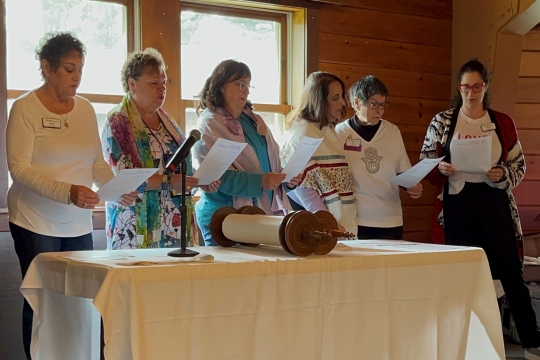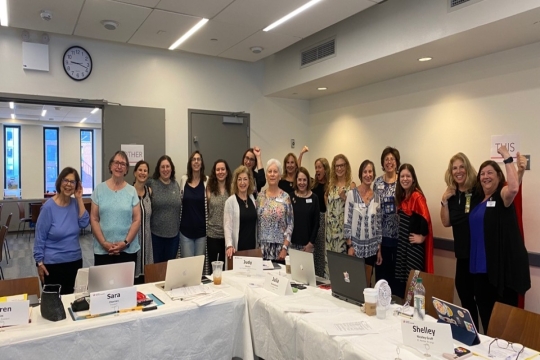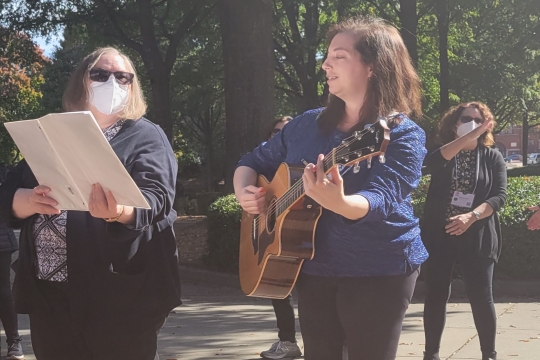by Gabrielle Grunau
The parashah for this week, Parashat P’kudei, starts with one verse to which I most responded. Following this first verse were more than 30 more verses describing the priestly garments and Tabernacle. P’kudei concludes both the book of Exodus and a series of parashot that began with Parashat T’tzaveh. P’kudei is the last in this series and it reiterates the engineering wonder and fashion statement Moses had described before.
The “wonder” of P’kudei is that the engineered construction had to have the capability of being set-up and broken down for “varying journeys” (Exodus 40:36) and the “statement” of P’kudei is that it calls for costumes to be tailored for an act on stage to be performed by priests. My favorite verse, however, is the first one, which has nothing directly to do with either. Rather it is a study of Moses’ desire for his work to be replicable through personal accountability.
One might ask what in P’kudei caused Moses to reiterate all he described previously in Parashat T'tzaveh. The answer, perhaps, is exactness. Moses repeated God’s instructions to the Israelites seemingly ad infinitum. Recounting was essential for God’s work to come to fruition.
The beautiful chronicle of P’kudei is rich with details not to be ignored in my focus on the first verse. For example, these details include designing the Tabernacle to have removable rods and curtains with sockets made of silver and copper; embroidering folded curtains made of rare materials such as dolphin skins studded with precious stones; and sewing sacral vestments with a cornucopia of specific colors of yarns.
Also included in detail are descriptions not only for embroidering priestly garments—tunics of only the finest linen hemmed with bells and pomegranates—but also for hammering sheets of gold into vests held by fine linen in the same colors as the sacral vestments and on which were studded precious stones. Once done, “In the first month of the second year on the first of the month, the Tabernacle was set up… as the Eternal had commanded Moses” (Exodus 40:17, 40:27).
Now, I return to the first verse of P’kudei, which tells that “These are the records of the Tabernacle” (Exodus 38:21). Moses’ first action in P’kudei was to hold himself accountable for the gold, silver, and copper expenditures of others. As preoccupied as he was and without being asked, Moses gave the Israelites insight into expenditures he made to fulfill God’s work as commanded.
The first verse, juxtaposed with all the intricate details of building and tailoring in the remaining verses, resonates and here is why: We too have expenditures as we attempt to perform Tikkun Olam daily in our lives. For those of us who are leaders, it may feel as if we are working alone. Using a personal example, I am the liaison connecting my sisterhood and congregation to WRJ and right now, there is no one else in my temple community doing what I do. I have singularly established an accounting of my non-reimbursable expenditures. For example, my expenditures for WRJ might be time given which belongs to my family and friends who see my work as meaningful because I have explained how the time directed to WRJ enhances the advancement of Reform Jewish women.
Being accountable for my time spent is accomplished by communicating results and may be seen as creating a blueprint for action, should my children or friends choose to use it. Accountability allows replication. I am cognizant how the first verse of this week’s parashah relates to my roles with WRJ and the account system I use.
No one told Moses to make an accounting of the communal finances that went into building the Tabernacle. Midrash tells us never should there be fewer than two persons responsible for contributions. The Tabernacle came into existence because God knew Israelites would set out on various journeys and wanted his presence with them on their way. Moses was alone in managing the gold, silver, and copper that were donated to build the Tabernacle. Moses made the choice of auditing himself without being asked. The first verse of P’kudei teaches me that accounting for our expenditures (both of shekels & time) as we journey, allows others to replicate God’s work as Tikkun Olam.
Gabrielle Grunau, is a WRJ Board member, WRJ Mid-Atlantic District Area Director and New Affiliates Committee Co-Chair and Parliamentarian at Washington Hebrew Congregation Sisterhood in Washington, D.C.
Related Posts
Image

Parashat Yom Rishon shel Rosh HaShanah
September 14, 2023
During the High Holidays, my thoughts turn to the special blessings, prayers, and melodies that shape our journey from Selichot to Rosh HaShanah to the final shofar blast on Yom Kippur. Many of our prayers in the High Holiday liturgy are written in the plural.
Image

Cultivating a Culture of Accountability and Belonging
September 8, 2023
And, we’re off! Many of us have worked over the summer with friends and colleagues to set the calendar for the year ahead, including meetings, events, and other opportunities for gathering.
Image

My Journey from Altar-Girl to Cantorial Soloist
August 11, 2023
I was born a Goldman, and always knew I was Jewish on my dad’s side. Although my whole family was spiritual in their own way, the Jewish side of my family didn’t have warm feelings towards religion, and the only thing passed down to me was the Jewish humor I grew up in New Jersey and had an open...
